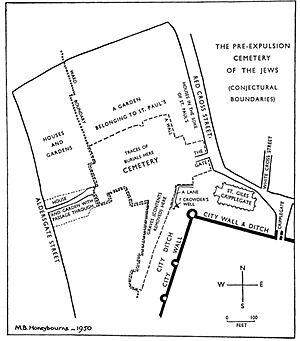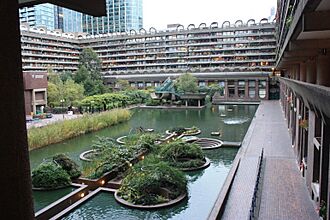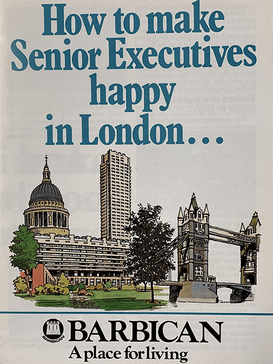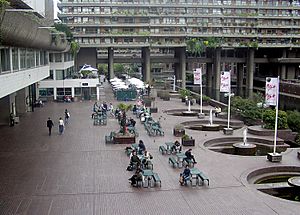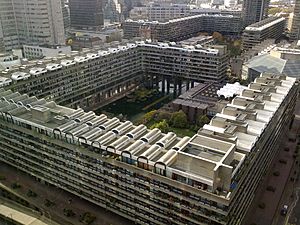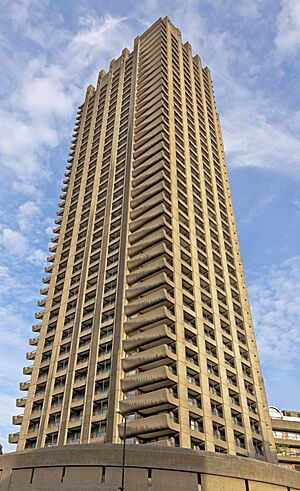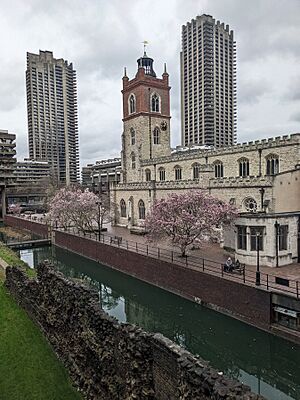Barbican Estate facts for kids
Quick facts for kids Barbican Estate |
|
|---|---|
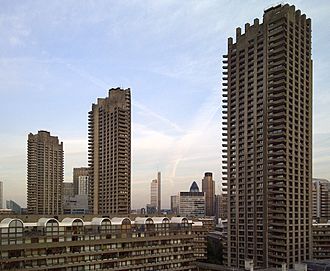
Barbican Towers
|
|
| General information | |
| Type | Mixed-use development |
| Architectural style | Brutalist/Fortress |
| Town or city | London |
| Country | England |
| Design and construction | |
| Architecture firm | Chamberlin, Powell and Bon |
| Structural engineer | Ove Arup & Partners |
| Civil engineer | Ove Arup & Partners |
| Designations | Grade II listed |
The Barbican Estate, also known simply as the Barbican, is a huge living area in central London, England. It has about 2,000 homes, including flats, maisonettes (flats on two levels), and houses. This area was badly damaged during World War II bombings. Today, it's a popular and fancy place to live.
The Barbican is part of a bigger area called the Barbican Complex. This complex includes the Barbican Arts Centre (a place for shows and events), the Museum of London, the Guildhall School of Music and Drama, a public library, and the City of London School for Girls.
The Barbican Complex is a famous example of brutalist architecture. This style uses lots of raw concrete and has a strong, bold look. The entire complex is a Grade II listed site. This means it's a special building that needs to be protected because of its history and design.
Contents
History of the Barbican Estate
Ancient Roots: Roman Fort and Walls

Long, long ago, between 90 and 120 AD, the main fort of Roman London was built in this area. Around 200 AD, strong walls were built around the city. These walls included the old fort, which became a grand entrance called Cripplegate.
The word barbican comes from an old Latin word, Barbecana. This word meant a fortified outpost or a gateway, like an outer defence for a city or a castle. It could also be a tower over a gate or bridge used for protection. In this case, there might have been a Roman watchtower in front of the fort. Later, the Normans called this area the Basse-cour or Base Court. This is similar to the word "bailey", which means an outer courtyard of a castle.
From Fort to Homes: Medieval Times
The Base Court continued to be used for military purposes during the time of Edward I. Later, Edward III gave it to Robert d'Ufford, 1st Earl of Suffolk, who made it his home in London. By the 1500s, it belonged to Charles Brandon, 1st Duke of Suffolk.
The original Base Court was eventually replaced by a large building called Willoughby House. This name is still used for a part of the modern Barbican today. This house later became known as Bridgewater House.
Interestingly, many of the Barbican's homes and green spaces are built on an area that was once a Jewish cemetery. This cemetery served the Jewish community in London before they were expelled from England in 1290.
Building the Modern Barbican
During World War II, the City of London was heavily bombed. The Cripplegate area, where the Barbican now stands, was almost completely destroyed. After the war, in 1952, people started discussing what to do with the ruined land. In 1957, the decision was made to build new homes there.
The Barbican Estate was built between 1965 and 1976 on a large site that had been bombed. It was designed by architects Chamberlin, Powell and Bon. Unlike some other housing projects, the Barbican was not built for social housing. Instead, it was planned for wealthy professionals and their families. The flats were rented out at market prices, meaning they were as expensive as other private homes in central London.
In its early years, many important people lived here, including politicians, lawyers, judges, and bankers. While the City of London owned and managed the Barbican, most flats are now privately owned. This is because of a law that allowed residents to buy their homes.
The first building, Speed House, opened in 1969. However, due to worker strikes, the last building, Shakespeare Tower, wasn't finished until 1976. Today, about 4,000 people live in 2,014 flats here.
The Barbican is known for its use of concrete, which is visible on the outside of the buildings. It's also special because it separates cars from people. Pedestrians walk on 'highwalks', which are elevated pathways, while roads and car parks are on lower levels.
In 2001, the Barbican complex was officially made a Grade II listed building. It's considered very important for its size, its unique design, and the big ideas behind the project. It's a key example of concrete brutalist architecture in London. You can also find lovely gardens and a community-run wildlife garden among the concrete buildings.
Buildings of the Barbican
The Barbican residential area has three tall tower blocks, 13 terrace blocks (which are long rows of homes), and other special buildings like mews and The Postern.
Terrace Blocks
These buildings are built around a lake and green areas. They rise up to seven floors above a podium level. This podium connects all the Barbican's facilities, creating walkways for people above the street. Some homes are even built into this podium structure. Cars are not allowed inside the main estate, but there are car parks nearby.
The terrace blocks are named after famous historical figures:
- Andrewes House – named after Lancelot Andrewes, a 16th-century bishop.
- Breton House – named after Nicholas Breton, a 16th-century poet.
- Bryer Court – named after a gold refiners' business that used to be there.
- Bunyan Court – named after John Bunyan, a 17th-century writer.
- Defoe House – named after Daniel Defoe, the English novelist.
- Frobisher Crescent – named after Martin Frobisher, an English seaman.
- Gilbert House – named after Sir Humphrey Gilbert, an English adventurer.
- Ben Jonson House – named after Ben Jonson, the English playwright.
- Thomas More House – named after Sir Thomas More, an English lawyer and philosopher.
- Mountjoy House – named after Christopher Mountjoy, who rented a room to William Shakespeare.
- Seddon House – named after George Seddon, an English cabinetmaker.
- Speed House – named after John Speed, an English mapmaker.
- John Trundle Court – named after John Trundle, a London publisher.
- Willoughby House – named after Catherine Willoughby, an English noblewoman.
Tower Blocks
The Barbican also has three very tall residential towers. They are 42 storeys high, reaching about 123 meters (400 feet). The very top floors of each tower have three special penthouse flats. The towers are:
- Cromwell Tower, finished in 1973 – named after Oliver Cromwell.
- Lauderdale Tower, finished in 1974 – named after the Earls of Lauderdale.
- Shakespeare Tower, finished in 1976 – named after William Shakespeare.
These towers were once the tallest residential buildings in London!
The Barbican Complex: Arts and Culture
The Barbican Estate is part of the larger Barbican Complex, which is a major cultural hub. It includes:
- The Barbican Centre, a famous place for arts, drama, and business events.
- The Barbican public library.
- The City of London School for Girls.
- The Museum of London.
- The Guildhall School of Music and Drama.
A YMCA building was also built nearby and has since been turned into new homes called Blake Tower.
At the heart of the Barbican complex is St Giles Cripplegate, a church that survived the bombings of World War II. You can also see parts of the old London Wall, built by the Romans, from the apartment balconies and in the park areas.
Famous People Who Lived Here
The Barbican has been home to many well-known people, especially when it was first built. Some famous residents include:
- Conservative politician Norman Tebbit.
- Labour Party leader John Smith.
- Former leader of the National Union of Mineworkers, Arthur Scargill.
- Former Prime Minister of Pakistan, Benazir Bhutto.
- Film and theatre director Sir Peter Hall.
- Footballer George Best.
- Artist Sir Michael Craig-Martin.
- Senior British judge Baron John Donaldson and his wife, Baroness Mary Donaldson, who was the first female Lord Mayor of London.
The Barbican in Movies and TV
The Barbican Estate has appeared in many films and TV shows, making it a recognizable landmark:
- It's featured in the novel In Search of Sixpence by Michael Paraskos.
- In the TV series Call the Midwife, Nurse Trixie Aylward mentions moving to the Barbican.
- The final scene of the 1983 vampire film The Hunger, starring David Bowie, was filmed in Cromwell Tower.
- Shakespeare Tower appears in the 2000 film Gangster No. 1.
- The Barbican towers can be seen in the 1975 Disney film One of Our Dinosaurs Is Missing.
- It was used to represent the MI6 headquarters in the James Bond film Quantum of Solace.
- Shots of the towers are on the record cover of the 1979 album Real to Real Cacophony by Simple Minds.
- The Barbican Estate is mentioned in the song "Language Lab" by the band Saint Etienne.
- The skyscraper in J.G. Ballard's novel High Rise was inspired by the Barbican towers.
- Lauderdale Tower is home to a character in the BBC series Luther.
- The Barbican Estate is featured in Skepta's "Shutdown" music video.
- It appears in several scenes of the Apple TV show Slow Horses.
- The brutalist complex was used as the backdrop for the fictional city of Coruscant in the Star Wars TV show Andor.
Getting There: Nearby Transport
| Service | Station/Stop | Line/Route |
|---|---|---|
| National Rail |
Liverpool Street | |
| Farringdon | ||
| Moorgate | ||
| London Underground |
Liverpool Street | |
| Barbican | ||
| Moorgate | ||
| St Paul's | ||
| Farringdon |
Images for kids
See also
 In Spanish: Barbican Estate para niños
In Spanish: Barbican Estate para niños


